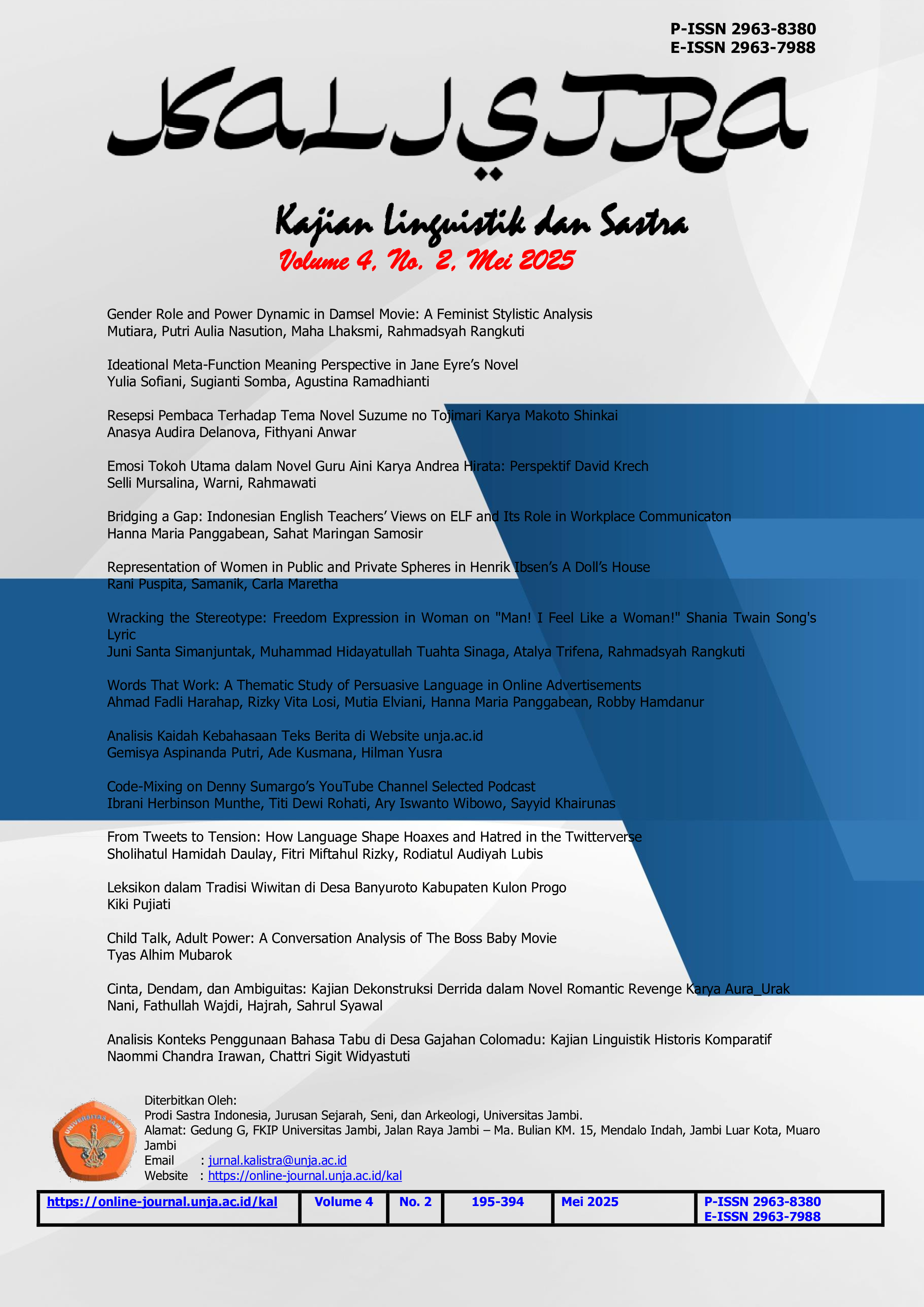Bridging a Gap: Indonesian English Teachers’ Views on ELF and Its Role in Workplace Communication
DOI:
https://doi.org/10.22437/kalistra.v4i2.43385Keywords:
Curriculum reform, English as Lingua Franca (ELF), Intercultural competence, Teacher's Perspective, Cross-Cultural CommunicationAbstract
This study explores Indonesian English teachers' perspectives on English as a Lingua Franca (ELF) and its importance in workplace communication. Using grounded theory and narrative inquiry, the research investigates the experiences of four vocational English teachers to identify challenges, strategies, and suggestions for curriculum reform. The findings revealed that teachers frequently face psychological and linguistic obstacles, such as limited vocabulary and cultural differences, which hindered effective ELF communication. To address these issues, teachers employed pragmatic strategies and cultural adaptation techniques to facilitate workplace interactions. The study highlights the need to shift from traditional grammar-focused instruction toward ELF-informed methodologies that emphasize comprehensibility, intercultural competence, and practical communication skills. This approach aims to better prepare vocational Indonesian students for the complexities of global workplace environments. Overall, the research suggests for an inclusive and flexible English education system that strengthen intercultural understanding and communicative proficiency, essential for successful international collaboration and cross-cultural communication.
Downloads
References
Aurini, J. D., Heath, M., & Howells, S. (2021). The How To of Qualitative Research.
Baker, W. (2015). Culture and Identity through English as a Lingua Franca: Rethinking Concepts. Berlin: De Gruyter Mouton.
Björkman, B. (2014). An analysis of polyadic English as a lingua franca (ELF) speech: A communicative strategies framework. Journal of Pragmatics, 66, 122–138.
https://doi.org/10.1016/J.PRAGMA.2014.03.001
Charmaz, K. (2014). Constructing Grounded Theory. 1–416.
Clandinin, D. J., Connelly, F. M., & Phelan, A. M. (2000). Shaping a professional identity: stories of educational practice. Alberta Journal of Educational Research.
Cogo, A., & Dewey, M. (2012). Analysing English as a Lingua Franca. Analysing English as a Lingua Franca: A Corpus-Driven Investigation, 1–216. https://doi.org/10.1080/0013838x.2014.998040
Crystal, D. (2003). English as a Global Language. Cambridge University Press.
Jenkins. (2000). The Phonology of English as an International Language. Oxford University Press.
Jenkins, J. (2014). Global Englishes: A resource book for students: Third edition. Global Englishes: A Resource Book for Students: Third Edition, 1–280. https://doi.org/10.4324/9781315761596
Kachru, B. B. (1992). World Englishes: approaches, issues and resources. Language Teaching, 25(1), 1–14.
https://doi.org/10.1017/S0261444800006583
Kankaanranta, A., Karhunen, P., & Louhiala-Salminen, L. (2018). “English as a corporate language” in the multilingual reality of multinational companies. Multilingua, 37(4), 331–351.
Kirkpatrick, A. (2010). English as a Lingua Franca in ASEAN: A Multilingual Model. Hong Kong University Press.
Kirkpatrick, A. (2012). English as an International Language in Asia: Implications for language education. 29–44. https://doi.org/10.1007/978-94-007-4578-0_3
Krashen. (1982). Acquiring a second language. World Englishes, 1(3), 97–101.
https://doi.org/10.1111/J.1467-971X.1982.TB00476.X
Low, E. L., & Pakir, A. (2017). Teaching English as an international language: a WE-informed paradigm for English language teaching. 104–117. https://doi.org/10.4324/9781315562155-17
Macintyre, P. D., Dornyei, Z., Clément, R., & Noels, K. A. (1998). Conceptualizing Willingness to Communicate in a L2: A Situational Model of L2 Confidence and Affiliation. The Modern Language Journal, 82(4), 545–562. https://doi.org/10.1111/J.1540-4781.1998.TB05543.X
Medygyes, P. (1994). The Non-Native Teachers. Macmillan.
Panggabean, H., Ke, I. C., & Perangin-Angin, A. B. (2023). L2 Confidence Development of ELF International Students in Taiwan. TEFLIN Journal, 34(2), 283–300.
https://doi.org/10.15639/TEFLINJOURNAL.V34I2/283-300
Rzońca, N. (2021). The Development of ELF-aware Classroom Materials. September.
https://doi.org/10.33422/3rd.educationconf.2021.03.225
Seidlhofer, B. (2013). Understanding English as a Lingua Franca. Oxford University Press.
Sifakis, N. C. (2019). ELF Awareness in English Language Teaching: Principles and Processes. Applied Linguistics, 40(2), 288–306. https://doi.org/10.1093/APPLIN/AMX034
Sifakis, N. C., Lopriore, L., Dewey, M., Bayyurt, Y., Vettorel, P., Cavalheiro, L., Siqueira, D. S. P., & Kordia, S. (2018). ELF-awareness in ELT: Bringing together theory and practice. Journal of English as a Lingua Franca, 7(1), 155–209. https://doi.org/10.1515/JELF-2018-0008/PDF/FIRSTPAGE
Thongphut, A., & Kaur, J. (2023). “Doing Explicit” in hospitality and tourism service encounters in English as a lingua franca. English for Specific Purposes, 70, 224–236.
https://doi.org/10.1016/J.ESP.2023.01.003
Topkaraoğlu, M. (2017). EFL Teachers’ Professional Development Efforts: A view from Turkey 1. Educational Research Association The International Journal of Research in Teacher Education, 1, 1–31. http://www.eab.org.trhttp//ijrte.eab.org.tr
Virkkula, T., & Nikula, T. (2010). Identity construction in ELF contexts: a case study of Finnish engineering students working in Germany. International Journal of Applied Linguistics, 20(2), 251–273.
https://doi.org/10.1111/J.1473-4192.2009.00248.X
Widodo, H. P. (2016). Language Policy in Practice: Reframing the English Language Curriculum in the Indonesian Secondary Education Sector. Language Policy (Netherlands), 11, 127–151.
Downloads
Published
How to Cite
Issue
Section
License
Copyright (c) 2025 Hanna Maria Panggabean, Sahat Maringan Samosir

This work is licensed under a Creative Commons Attribution-ShareAlike 4.0 International License.
Kalistra: Kajian Linguistik dan Sastra is licensed under Creative Commons Attribution-ShareAlike 4.0 International License.
Authors who publish their manuscripts in Kajian Linguistik dan Sastra agree to the following terms:
1. The copyright in each article belongs to the author.
2. The author acknowledges that Kajian Linguistik dan Sastra reserves the right to be the first to publish under a Creative Commons Attribution-ShareAlike 4.0 International License (Attribution 4.0 International CC BY-SA 4.0).
3. Authors may submit articles separately, arranging for non-exclusive distribution of manuscripts that have been published in this journal to other versions (e.g., delivery to the author's institutional repository, publication into a book, etc.), acknowledging that the manuscript has been first published in Kajian Linguistik dan Sastra.
















